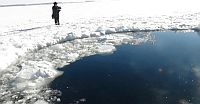
Photo: Reuters
A large round hole in the ice of Lake Chebarkul, 80 kilometers west of the Russian city of Chelyabinsk in the Urals, may have been made by a fragment of the meteor which exploded in a massive fireball above the region on Friday. The shockwave from the meteor damaged 4,000 buildings and injured some 1,200 people, mostly from flying glass. Divers are scouring the bottom of Lake Chebarkul looking for fragments of the meteor. Thus far no other fragments have been found from the meteor in the region.
Divers scour Russian lake after meteor strike injures 1,200
The meteor explosion appears to be one of the most stunning cosmic events above Russia since the 1908 Tunguska Event in which a massive blast most scientists blame on an asteroid or a comet ripped through Siberia.
Scientists at the US space agency Nasa estimated that the amount of energy released from impact with the atmosphere was about 30 times greater than the force of the nuclear bomb dropped on the Japanese city of Hiroshima during World War II.
“We would expect an event of this magnitude to occur once every 100 years on average,” said Paul Chodas of Nasa’s Near-Earth Object Program Office.
“When you have a fireball of this size we would expect a large number of meteorites to reach the surface and in this case there were probably some large ones,” he said in a statement published on the NASA website.

#1 The hole is manmade.
Look at that photo closely.
Notice the man is standing near a big saw? Notice the + mark over his pant legs just above his boots? That + is part of the saw handle. The saw runs along the ice to the left of our screens, look and you can make it out. Its partly in his shaddow.
#2 Some reporter didn’t do their homework!
If the following headline were true, that city wouldn’t be there now.
“”Russian meteor hit with force of 30 Hiroshima bombs:Telegraph.co.uk””
http://www.telegraph.co.uk/science/space/9874662/Russian-meteor-hit-with-force-of-30-Hiroshima-bombs.html
I cannot comment on the photo but the statement about the force of the air blast is from NASA. Obviously, if the blast is high enough, the force is pretty dispersed widely. It also helps explain why the meteor itself was largely vaporized. The Hiroshima bomb exploded at 600 meters above the ground whereas the meteor over Russia exploded at an estimated 30 to 50 km above the ground.
I think we’ve seen a warning. I pray that the next one is bigger and lands in Washington DC. Then, and only then can America start rebuilding it’s governmental woes. Americans are so fat, dumb, and happy. They need a little jolt to wake them up.
As my reference with regards to the Telegraph article above, I used the Wiki article on the Little Boy Atomic bomb.
“It exploded with an energy of 16 kilotons of TNT (67 TJ). It has been estimated by neutral sources that 90,000-166,000 people had died as a result of its use by the end of December 1945.” http://en.wikipedia.org/wiki/Little_Boy
The end is near, thats all I got to say.